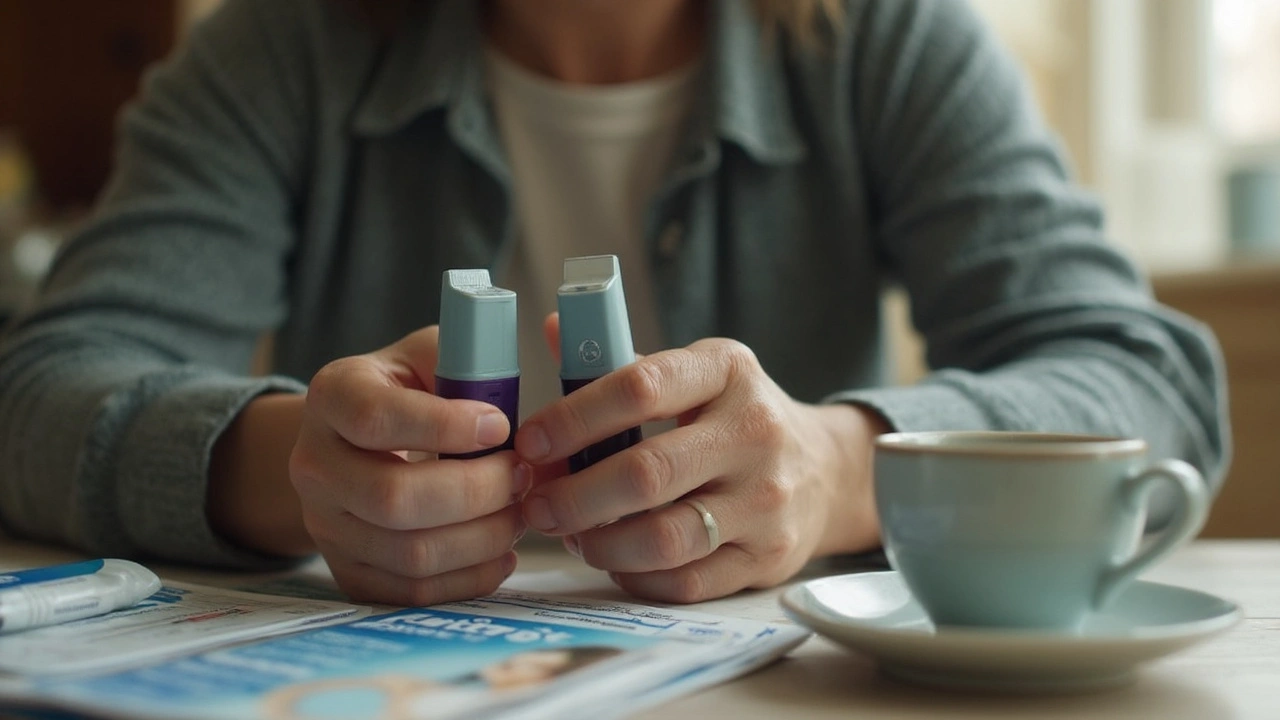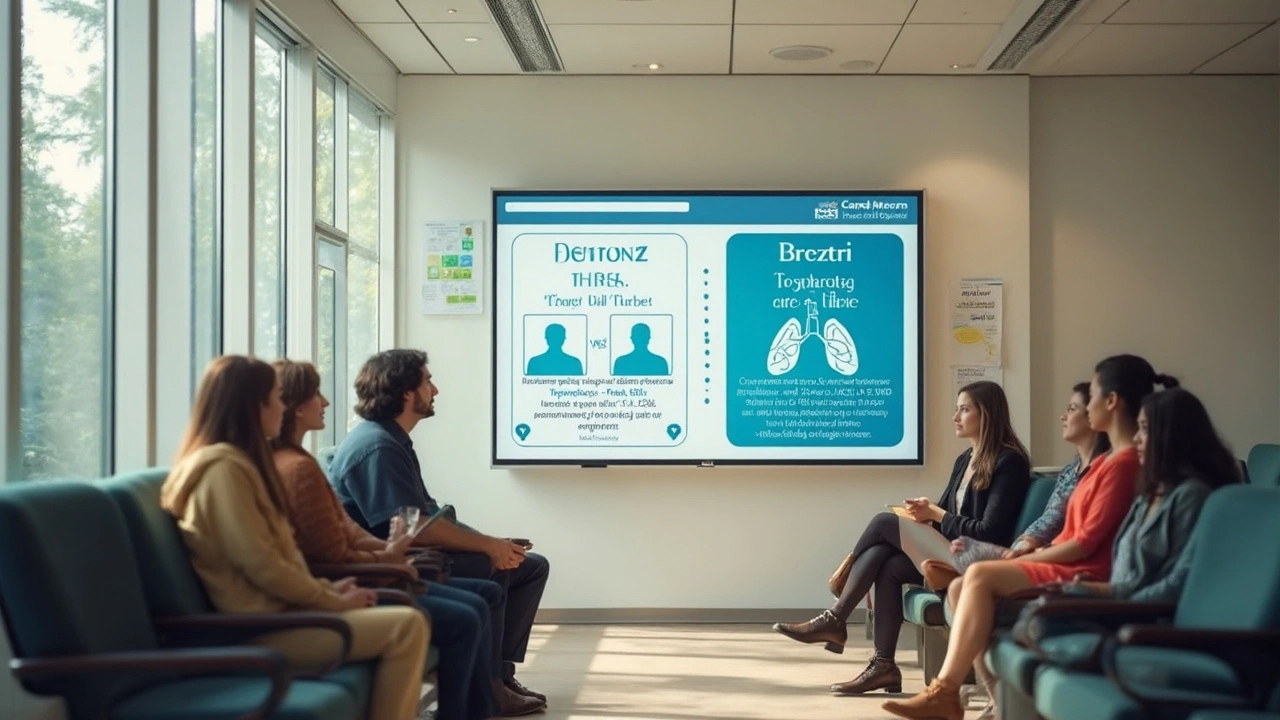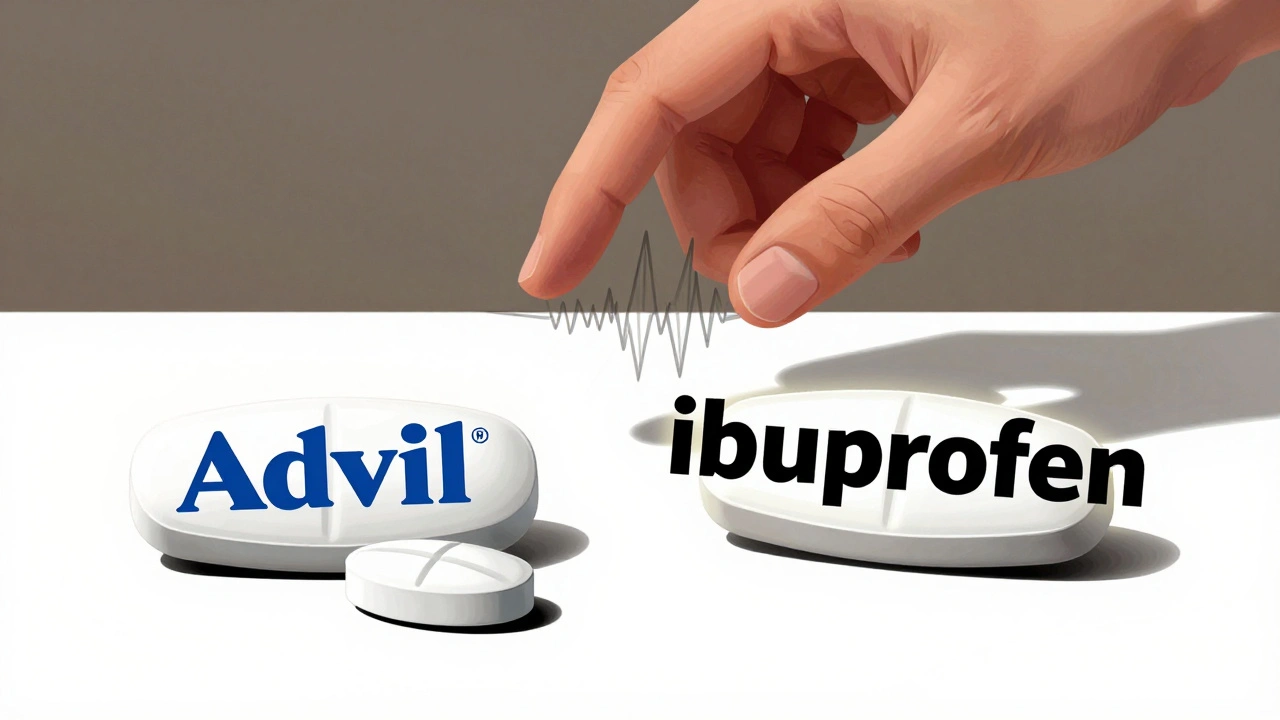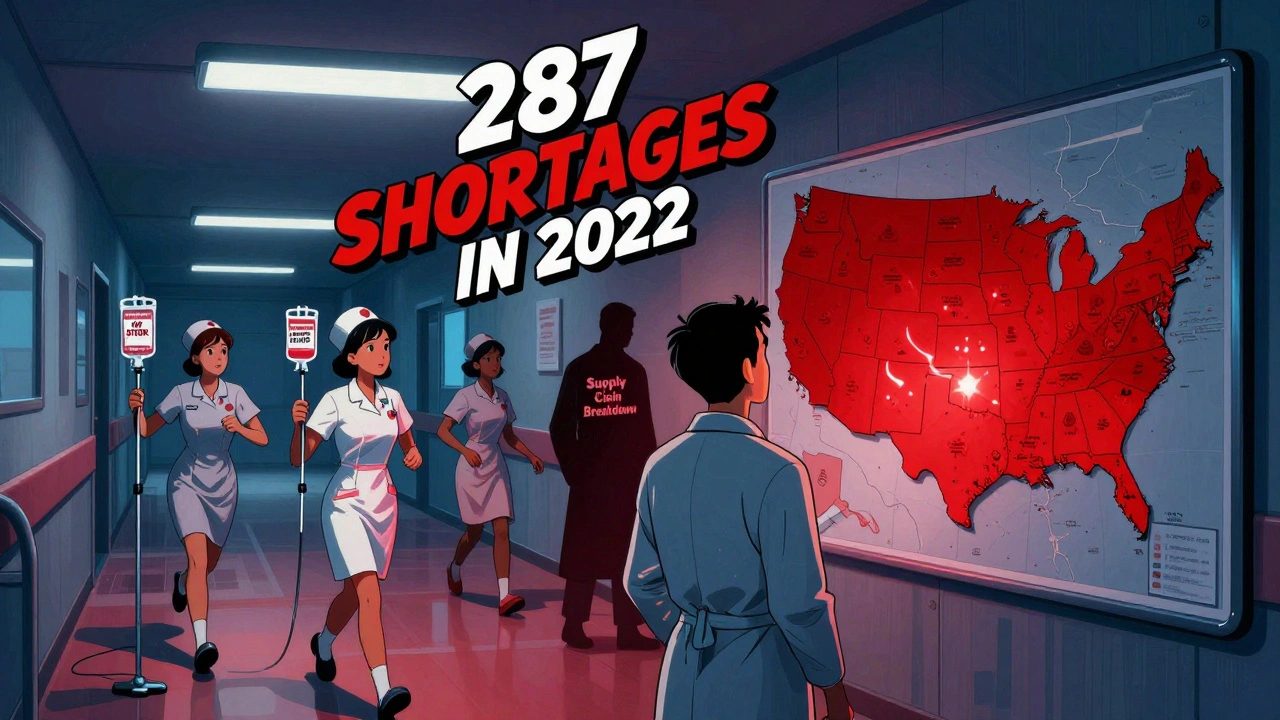Picture this: you’re struggling up stairs, every breath feels tight, and your current COPD inhaler just isn’t cutting it. The frustration of living with chronic obstructive pulmonary disease (COPD) can make every day feel like a slog. Australia’s coastal climate doesn’t help—one bad air day and flare-ups are back. There’s lots of talk in the respiratory community about triple therapy—could Breztri Aerosphere finally be the solution that outperforms Symbicort?
Understanding the Difference: How Breztri and Symbicort Work
Symbicort has been a go-to for years—most folks on inhaled therapy know it. It’s a combo of budesonide (an inhaled corticosteroid, ICS) and formoterol (a long-acting beta agonist, LABA). That two-pronged approach helps manage airway inflammation and relaxes the muscles, making breathing easier. But for a lot of people with moderate to severe COPD, two medications aren’t always enough. That's where the new kid on the block comes in: Breztri Aerosphere. Breztri bumps up the therapy by adding a third medication—a long-acting muscarinic antagonist (LAMA), glycopyrronium. In plain talk, it blocks certain signals in your lungs that tighten airways, opening things up even more.
The big idea behind triple therapy is simple: hit inflammation (ICS), stop airway tightening (LAMA), and keep muscles relaxed (LABA), all in one puff. Studies published in 2023 and 2024 showed that patients using Breztri had fewer exacerbations than those on dual therapy, including Symbicort. If you’re getting more than two flare-ups a year or your breathing isn’t controlled, you might be starting to wonder if triple is the way to go.
What really sets Breztri apart is its innovation in delivery. Its “pMDI” (pressurized metered-dose inhaler) technology helps ensure you get all three drugs deep into your lungs effectively. For people in Australia who can struggle with dry-powder inhalers during hayfever season or bushfire smoke, this can actually make a difference.
When Does Breztri Outperform Symbicort?
Let’s not sugarcoat it: not everyone with COPD needs triple therapy out of the gate. If your symptoms are mild and you’re cruising along with Symbicort, there may not be a pressing reason to switch. But if your disease has progressed—more shortness of breath, finding it hard to shake winter bronchitis, or winding up in hospital more than you’d like—that’s when it’s time to talk alternatives.
Results from the ETHOS and KRONOS clinical trials—two of the biggest studies comparing dual and triple therapy—were clear. In patients with a history of exacerbations, Breztri Aerosphere reduced the risk of moderate or severe flare-ups by up to 24% over a year versus dual therapy (like Symbicort). There was also a noticeable bump in lung function: on average, people using Breztri could blow out about an extra 50-70 mL of air in their FEV1 tests (the amount you can force out in a single breath) compared to those using Symbicort. It’s not dramatic like a night-and-day epiphany, but for someone teetering on the edge, every extra bit of lung function feels like a win.
Here’s a concrete example. Sarah, 67, from Geelong, had been using Symbicort for years but still landed in the Emergency Department after each winter cold. Her doctor swapped her to Breztri—you’d think it’d take months to notice. Within five weeks, her coughs and wheezing settled. She still juggles bills and family, but climbing up the tram steps doesn’t terrify her now. Not everyone notices this quick of a change, but that’s the promise Breztri brings for folks who can’t seem to stay out of trouble with their existing inhaler.
Another big tick in Breztri’s column is tackling “morning symptoms.” Those dreaded early coughs and tight chests that make getting out of bed feel impossible are often quieter with triple therapy. Real-world data in 2024 also suggests that patients miss fewer workdays after switching to Breztri compared to staying with Symbicort.
Let’s see how the numbers stack up in clinical trials:
| Study | Reduced Exacerbations (%) | Improvement in FEV1 (mL) | Hospitalisations Avoided |
|---|---|---|---|
| ETHOS (2020-2023) | 24% | up to 70 | 1.2 fewer/year |
| KRONOS (2019-2022) | 20% | 50-60 | 1 fewer/year |

Pros and Cons: Side Effects, Convenience, and Switching Tips
Every good story needs a dose of reality—triple therapy isn’t perfect. Breztri Aerosphere shares many of the same potential side effects as Symbicort. The classics: hoarse voice, oral thrush (always rinse your mouth after using any inhaler with steroids), and sometimes a pounding heart. One specific thing to watch out for with Breztri, though, is a slightly higher risk of pneumonia. The ETHOS trial did flag this: about 4.8% of patients had a pneumonia episode, compared to 3.9% on dual therapy.
Here’s what folks usually want to know before switching:
- Convenience: You’re still looking at two puffs, twice a day. No major hassle increase if you’re used to Symbicort.
- Learning curve: Breztri’s inhaler style is familiar for most people—smooth transition for those already using a pMDI inhaler.
- Compatibility with other medication: Always check with your doctor if you’re on heart meds, as triple therapy can interact with certain cardiovascular treatments.
If you’re thinking about making the jump, don’t try DIY. Pharmacists and GPs often recommend overlapping your old and new inhalers for a few days to avoid any gap in your therapy. Expect a check-up in about four weeks so the doctor can watch for side effects or improvement. And don’t forget: inhaler technique is 95% of the battle. Even a “miracle” drug won’t work if it’s sprayed at your tongue, not your lungs. Have someone watch (embarrassing, but a lifesaver).
When Symbicort Still Shines: Who Shouldn’t Switch?
Symbicort hasn’t stuck around out of nostalgia. For people who haven’t landed in the hospital or who only deal with the odd seasonal cough, it’s still an excellent option. The fewer drugs you need, the lower your side effect risk—and Symbicort’s well-established safety profile appeals to a lot of doctors.
There are certain groups where Breztri isn’t an automatic upgrade:
- Asthma-only patients: Triple therapy is really meant for COPD patients. Asthmatics don’t get the same benefit, and triple therapy is generally not approved for regular asthma management.
- People with a heavy history of pneumonia: If you’ve been knocked out by chest infections before, the extra steroid burden might make you more vulnerable.
- Mild symptom folks: You might not see enough extra benefit to justify the extra medication.
- Those sensitive to anticholinergic side effects: The LAMA in Breztri (glycopyrronium) can dry you out or trigger constipation and urinary retention, especially in older men.
There’s no one-size-fits-all. The smartest way is to get a lung function test--yes, blowing into those weird tubes in your GP’s office is awkward, but it helps nail down your treatment plan. If you don’t want to jump up to a triple or feel like your cough is mostly at bay, Symbicort remains a gold standard.

Looking for Alternatives: Cost, Access, and Real-World Choices
If you’ve priced an inhaler at your local chemist lately, you know the sticker shock. Both Symbicort and Breztri are covered under the PBS (Pharmaceutical Benefits Scheme) in Australia for those who qualify, but there are still upfront costs, especially if you’re not on a concession card. Some insurance plans in other countries only approve one or the other, so always double check with your provider.
The most common question I’ve had from mates lately: What if I want something like Breztri but my budget or chemist doesn’t stock it? There are plenty of options around—other triple therapy combos are slowly arriving (like Trelegy Ellipta), and some patients stay on dual therapy but add a LAMA with a separate puff. There’s a thorough breakdown of choices at this Breztri Aerosphere alternative guide, listing the most up-to-date options for 2025. Worth a read if you’re trying to weigh up your choices.
Here are a few quick tips for getting the best out of your inhaler, no matter which you use:
- Consistency wins: Don’t skip doses just because you feel okay for a day, especially in winter or pollen season.
- Ask your chemist about spacers: They help inhale the full dose and reduce side effects from steroids.
- Log your symptoms: If you’re new on Breztri, write down every noticeable change in a diary. It gives your doctor concrete info at checkups.
The world of inhalers keeps moving fast—what was ‘new’ a year ago is ‘standard’ today. The big shift is more people qualifying for triple therapy earlier, as guidelines keep adjusting in 2025. If Symbicort is no longer enough for you, Breztri Aerosphere is probably your next step up—especially if you want to bring down flare-ups, avoid winter hospital visits, or finally feel a difference in your daily breath. No inhaler fixes everything, but knowing your best options is as close as it gets to breathing easier, day in and day out.







harold dixon
May 20, 2025 AT 00:55I've been following the COPD inhaler debate for a while now and I can’t help but feel a pang of empathy for anyone still wrestling with breathlessness. The way Breztri layers a LAMA onto the classic ICS/LABA combo is a clever twist that could ease the daily grind for many. Still, I wonder how much of the reported FEV1 boost translates into real‑world stamina on the stairs. If you’ve tried both, sharing a quick snapshot of your symptom diary would be gold. Either way, kudos to the clinicians pushing the envelope.
Darrin Taylor
May 21, 2025 AT 04:13Everyone’s hailing Breztri as the next miracle, but have you considered who’s really benefitting? The pharma giants have a vested interest and the data pipelines are far from transparent 🧐. I’m convinced there’s a hidden agenda to keep us dependent on ever‑more expensive combos. Still, if you’re lucky enough to snag a decent discount, the extra LAMA might tip the scales. Just keep your eyes peeled for the fine print.
Anthony MEMENTO
May 22, 2025 AT 09:23Breztri represents a paradigm shift in COPD management. The addition of glycopyrronium to the budesonide‑formoterol backbone creates a triple action that theoretically covers inflammation bronchoconstriction and muscarinic tone. Clinical trials such as ETHOS and KRONOS have shown statistical reductions in exacerbations. The magnitude of those reductions hovers around twenty‑four percent which is not negligible. Moreover the modest FEV1 improvement of up to seventy millilitres can be meaningful for patients perched on the edge of functional decline. Critics argue that the benefit–risk ratio is diluted by a marginally higher pneumonia incidence. The data in that regard is still evolving and warrants cautious interpretation. From a pharmacoeconomic standpoint the cost differential may be justified in high‑risk cohorts. The inhaler device itself employs a pMDI platform that many patients find user‑friendly during allergy seasons. However the technique sensitivity remains a challenge for the elderly with limited dexterity. Real‑world evidence from Australian registries suggests adherence rates improve when patients switch to Breztri. Yet adherence is a multifactorial construct and cannot be solely attributed to device design. In practice the decision to upgrade should be individualized based on exacerbation history and comorbidities. Ultimately the physician’s role is to balance the incremental lung function gain against potential side effects. When that equilibrium is achieved Breztri may indeed be the optimal step for select COPD sufferers.
aishwarya venu
May 22, 2025 AT 11:20That’s a solid rundown and I appreciate the balance you struck between data and patient perspective. It’s encouraging to see the nuance and not just a blanket endorsement.
Nicole Koshen
May 23, 2025 AT 14:33I noticed a couple of places where the article could tighten up its grammar-for example, “there’s lots of talk” might be better as “there is a lot of talk.” Also, “the big idea” could be capitalized consistently as a subheading. Small edits like these help maintain credibility, especially in medical writing.
Ed Norton
May 23, 2025 AT 15:56Nice summary.
Karen Misakyan
May 24, 2025 AT 18:20From a phenomenological standpoint, the transition from dual to triple therapy embodies a dialectic between therapeutic sufficiency and iatrogenic burden. One might argue that the ontological essence of breath is preserved when the pharmacologic triad synergistically addresses the multifaceted pathology of COPD. However, the epistemic limits of clinical trials necessitate a cautious extrapolation to individual lived experience. In this regard, the physician must serve as a hermeneutic bridge, translating statistical outcomes into tangible relief for the patient’s quotidian existence.
Amy Robbins
May 24, 2025 AT 19:10Interesting prose but you might want to watch your comma splices-“The transition from dual to triple therapy embodies a dialectic between therapeutic sufficiency and iatrogenic burden” could use a semicolon instead. Also, “phenomenological standpoint” sounds pretentious when a simple “viewpoint” would do. Just saying.
Shriniwas Kumar
May 25, 2025 AT 22:06When evaluating the pharmacokinetic profile of glycopyrronium within the triple matrix, one must consider receptor occupancy dynamics and the resultant bronchodilatory plateau. The pMDI delivery system optimizes aerosol particle size distribution, enhancing deep lung deposition-a critical factor in overcoming mucociliary clearance barriers prevalent in Australian bushfire seasons.
Jennifer Haupt
May 27, 2025 AT 01:53First and foremost, thank you all for sharing such detailed experiences; it’s heartening to see a community so invested in each other’s pulmonary health. The decision to transition to a triple regimen should be anchored in a comprehensive assessment that includes spirometry trends, exacerbation frequency, and personal lifestyle goals. For patients who juggle work, family, and the occasional smoke exposure, even a modest reduction in hospital visits can translate into regained quality of life. It’s also vital to engage a multidisciplinary team-pulmonologists, pharmacists, and respiratory therapists-to ensure proper inhaler technique and monitor for side effects like pneumonia. Moreover, documenting symptom changes in a structured diary can provide concrete data for the next clinical review. Lastly, never underestimate the psychological boost that comes from feeling heard and supported in the treatment journey.
NANDKUMAR Kamble
May 27, 2025 AT 03:16When I read the above, I felt a surge of hope that was quickly eclipsed by the looming specter of institutional negligence-our lungs are battlegrounds, and the stakes are nothing short of survival.
namrata srivastava
May 28, 2025 AT 05:40The epistemic hierarchy inherent in inhaler selection underscores a broader sociomedical stratification; namely, access to triple therapy delineates a cohort of privileged patients poised to capitalize on cutting‑edge pharmacotherapy.
Priyanka arya
May 28, 2025 AT 06:30Love the vibe here 😂! If you’re on a budget, check if your local pharmacy runs a bulk‑buy program – sometimes you can snag a month’s supply for less than a coffee ☕️.
Loren Kleinman
May 29, 2025 AT 09:26I have been thinking about the whole inhaler discussion for a long time. The main point is that each drug has a purpose. The steroid reduces inflammation. The long‑acting beta agonist relaxes muscles. The anticholinergic blocks tightening signals. When they are all together they cover more ground. Some people do fine with just two of them. Others need the full three. It really depends on how bad the disease is. Doctors have to look at each case. Patients should speak up about their symptoms. That way the treatment can be adjusted.